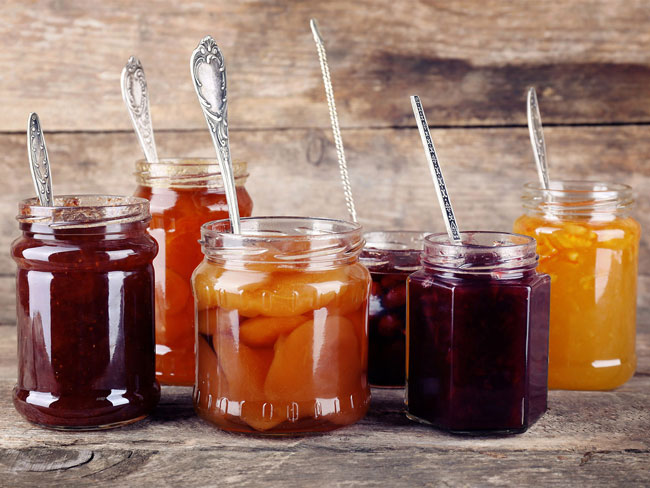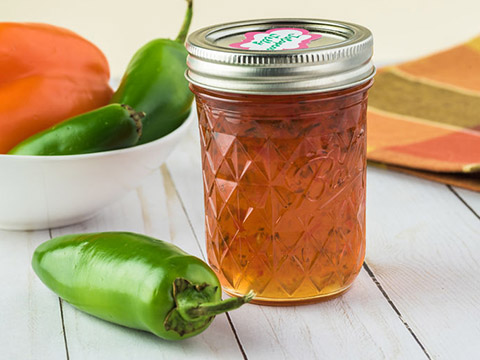Taking Canning to the Next Level
- By Erin Mittelstaedt
- Reading Time: 6 mins.
 Canning helps us make new family traditions and memories. This year included a kitchen covered in splashes of red pomegranate juice, mashing batches of persimmons to music, and making massive amounts of spaghetti sauce with my brother’s family, kids and all. I often hear stories like these from canners about how canning brings family and friends together throughout the seasons.
Canning helps us make new family traditions and memories. This year included a kitchen covered in splashes of red pomegranate juice, mashing batches of persimmons to music, and making massive amounts of spaghetti sauce with my brother’s family, kids and all. I often hear stories like these from canners about how canning brings family and friends together throughout the seasons.
I love canning because it’s a practical and creative activity that has so many benefits: not only does it minimize waste—it also allows us to make seasonal produce last well past its harvest. Opening a jar of homemade applesauce in spring can take you right back to fall.
It wasn’t until I started working for The FruitGuys that I began to explore canning. It was fall of 2007, and we were suddenly inundated with farm-fresh apples and pears. I wanted to do something to hold on to them through the winter. That year I tried my first canning project: jars of simple applesauce and sliced pears with vanilla. The hardest part was getting the timing right between cooking the fruit and sealing the jars. It seemed to take forever to boil the water for my water bath (where you put the filled jars to seal them) because I put it on the stove too late. I didn’t have any canning tools, so I carefully used tongs to remove the sterilized jars from the hot water. This worked, but only after splashing hot water everywhere! Overall though, it was a success—I was relieved to hear the satisfying pop of the jars sealing as they cooled. Canning—I realized—wasn’t as hard as it seemed.
Get tips for your office
Be an office hero!
This year I decided to take on the next level in fruit canning: jams and jellies.
Making jams and jellies requires the use of pectin, a naturally occurring substance in fruits that, when cooked, creates the smooth jelly-like thickness that we know and love. Pectin is naturally found in many fruits but store-bought pectin is usually derived from citrus peels. Adding pectin will decrease the cooking time of your jam and allow you to control its consistency.
One Christmas, I tasted a homemade hot pepper jelly that had the perfect balance of sweet and spicy. It was served spread over cream cheese on crackers. Delicious. I decided this would be my first jelly project. After doing some research, I learned that not all pectin is the same. I decided to try pectin called Pomona’s Universal Pectin. It’s 100% natural and unlike most pectin, its gelling properties are activated by calcium water instead of sugar. This allows you to use less sugar when making jams or jellies. Additionally, the box has some great recipes and guidelines on how to create your own recipes.
Want fruit for your office?
Get your office a free sample TODAY!
Pomona’s red pepper jelly recipe is simple and only requires six ingredients: red peppers, jalapeño peppers, apple cider vinegar, sugar, pectin, and calcium water. (The calcium for the calcium water is included in every box of Pomona’s Pectin.)

Hot Pepper Jelly
Courtesy of Pomona’s Universal Pectin
INGREDIENTS
4 red peppers, finely chopped (3 ½–4 cups)
3 jalapeño peppers; seeds removed and finely chopped (⅓–½ cup)
4 cups apple cider vinegar
6 teaspoons calcium water (calcium powder and instructions included in Pomona’s Pectin box)
6 cups of sugar
4 ½ teaspoons Pomona’s Universal Pectin powder
PREPARATION
- Wash and rinse canning jars. Place canning jars, lids, and bands in hot water (180°F) for at least 10 minutes. Let stand in hot water until ready to fill.
- Remove jars, lids, and bands one at a time as needed.
- Bring red peppers, jalapeños, and apple cider vinegar to a boil.
- Simmer, covered, for 5 minutes.
- Stir in calcium water.
- Measure 1 cup of sugar into a separate bowl.
- Add and thoroughly mix pectin powder into sugar.
- Bring pepper mixture to a boil and slowly add in the sugar-pectin mixture, stirring vigorously until dissolved. Once dissolved, stir in remaining 5 cups of sugar. Once all the sugar is incorporated, remove from heat.
- Fill jars to ¼–inch from the top. Wipe rims clean and screw on 2-piece lids. Put filled jars in boiling water covered by at least one inch of water. Cover pot and boil for 10 mins (add 1 minute more for every 1,000 feet above sea level). Remove from water and let jars cool.
- Once cooled (can take up to 12–24 hours), check seals and lids. They should be sucked down.
Want fruit for your office?
Get your office a free sample TODAY!
Yields about 12 jars. Prep time, 35–45 mins.
I used a food processor to finely chop the peppers, but you can chop them by hand as well. Be careful with the jalapeños! I made the mistake of using my bare hands when cleaning them and then rubbed my eye, which immediately felt like it was on fire. Use gloves when working with jalapeños.
It took some trial and error to get the jelly exactly how I wanted it. My first batch was a little thinner then I would have liked, so when making the second batch, instead of adding the suggested ratio of sugar and pectin, I added more pectin. As I was pouring the mixture into my jars, I could see that the jelly became thicker—a thick film was forming on my spoon and the top layer of the jelly was gelling. I could’ve corrected this at the time by boiling the mixture again and adding a ½ cup of the pepper-apple cider vinegar mixture, but I wanted to see how this would jell up when it cooled. Sure enough, I had added too much pectin. When I opened a jar the next day after it had cooled, it looked completely unappetizing. It was so thick it looked like a Jell-O mold. The next batch I made was perfect.
 Overall, working with pectin was more forgiving than I originally thought. Now that I am no longer intimidated by pectin—I feel like a whole new world of canning creations has opened up. Anything is possible!
Overall, working with pectin was more forgiving than I originally thought. Now that I am no longer intimidated by pectin—I feel like a whole new world of canning creations has opened up. Anything is possible!
Canning, like cooking, allows you to experiment and express your creativity to create items that may not be commercially available. I had never seen pomegranate jelly until a family friend made it from the pomegranates that she grew in her yard. It was so delicious and beautiful that it inspired me to do the same. An additional benefit of making your own jams or jellies is that you can tailor them to your tastes and dietary needs: I made a lower calorie pomegranate jelly by using pectin that works with low sugar.
If you’re a beginner like me, just make sure you check a reputable source like The National Center for Home Food Preservation. You need to check the acidity (pH level) of the ingredients in your recipe to be sure that it will be safe to can in a water bath (most low acid foods, such as vegetables and meats, have to be canned in a pressure canner).
Want farm-fresh fruit?
We've got you covered.
By giving the things we’ve made to our family and friends, we’re able to share with them something that we’ve put our heart and love into, which always feels wonderful. Even if you don’t can, find a friend who does and help out. You may be inspired to try it yourself.
Erin Mittelstaedt is COO of The FruitGuys.


